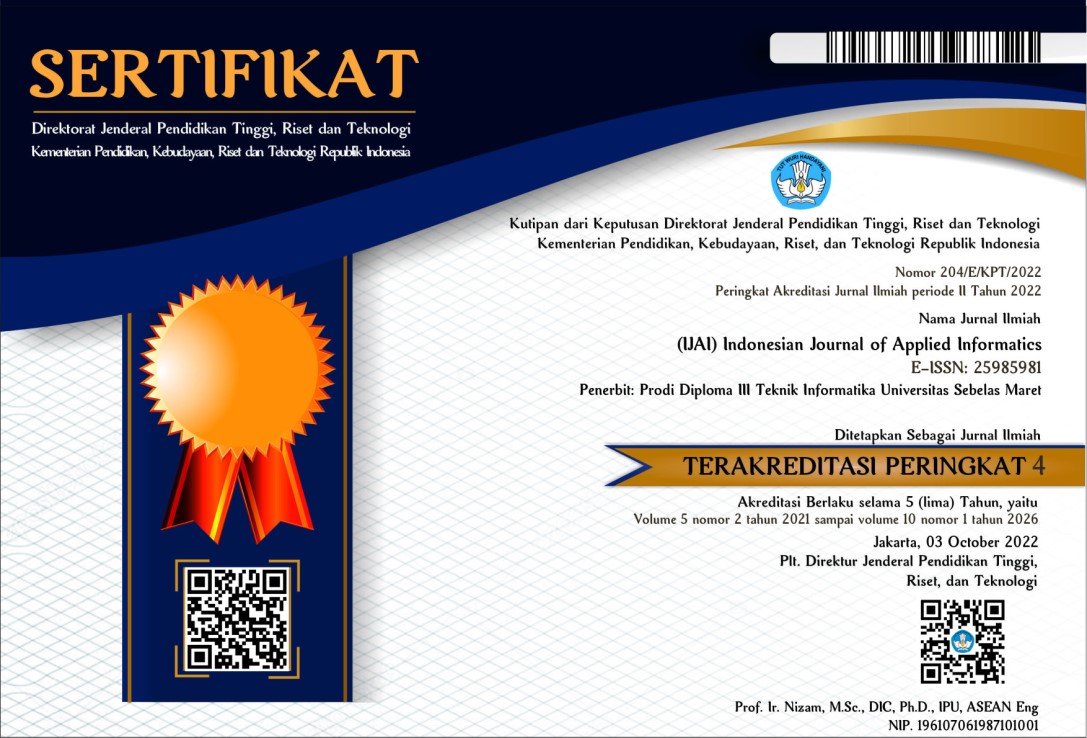Optimasi Pemanfaatan RSSI-Wifi Sebagai Asisten Navigasi Lokasi Gedung Politeknik Negeri Semarang Berbasis Android
Abstract
Abstrak
Studi ini menyelidiki sistem navigasi dalam ruangan berbasis WiFi untuk menentukan lokasi bangunan. Sistem ini dikembangkan menggunakan metode sidik jari dari Received Signal Strength Indication (RSSI) dari masing-masing Access Point (AP). Komponen utama dari sistem berbasis smartphone menggunakan data dari WiFi dan Global Positioning System (GPS). Aplikasi yang dikembangkan untuk navigasi dirancang dan diimplementasikan sebagai elemen dari pencarian lokasi gedung dan aplikasi penentuan rute ke lokasi bangunan. Data peta bangunan dikumpulkan dari data GoogleMap yang disempurnakan dengan mewarnai lokasi geografis bangunan yang ditampilkan di perangkat seluler. Alat bantu navigasi yang dikumpulkan dari sensor memberikan orientasi perjalanan dan pembaruan posisi. Penentuan rute dihitung dengan rumus Haversine. Serangkaian percobaan dilakukan di wilayah Politeknik Negeri Semarang, Indonesia. Hasil penelitian menunjukkan bahwa sistem pemosisian dalam ruangan berbasis WiFi akurat dalam jarak sekitar 7.050 m, sehingga membuktikan kegunaan sistem untuk menentukan lokasi bangunan di area kampus. Sistem ini dapat digunakan untuk membantu pengunjung tanpa harus bertanya meskipun mereka hanya berkunjung sekali.
Abstract
This study investigates a WiFi-based indoor navigation system to determine building locations. This system was developed using the fingerprint method from the Received Signal Strength Indication (RSSI) from each Access Point (AP). The main components of the smartphone-based system use data from WiFi and Global Positioning System (GPS). The application is designed and implemented as an element of building location search and route determination application to building location. Building map data is collected from enhanced GoogleMap data by coloring in the geographic locations of buildings that displayed on mobile devices. Navigational devices collected data from sensors provide trip orientation and position updates. Route determination is calculated by the Haversine formula. A series of experiments were carried out at the Semarang State Polytechnic, Indonesia. The results show that the WiFi-based indoor positioning system is accurate within a range of about 7,050 m, thus proving the usefulness of the system for determining the location of buildings in the campus area. This system can be used to help visitors without having to ask even if they only visit once.
Keywords
Full Text:
PDFReferences
[1] Politeknik Negeri Semarang, “Politeknik Negeri Semarang Website,” https://www.polines.ac.id, 2019. www.polines.ac.id.
[2] V. Hromadová, J. Machaj, and P. Brída, “Impact of user orientation on indoor localization based on Wi-Fi,” Transp. Res. Procedia, vol. 55, no. 2019, pp. 882–889, 2021, doi: 10.1016/j.trpro.2021.07.056.
[3] S. Sukreep, C. Nukoolkit, and P. Mongkolnam, “Indoor position detection using smartwatch and beacons,” Sensors Mater., vol. 32, no. 2, pp. 455–473, 2020, doi: 10.18494/SAM.2020.2386.
[4] R. F. Brena, J. P. García-Vázquez, C. E. Galván-Tejada, D. Muñoz-Rodriguez, C. Vargas-Rosales, and J. Fangmeyer, “Evolution of Indoor Positioning Technologies: A Survey,” J. Sensors, vol. 2017, 2017, doi: 10.1155/2017/2630413.
[5] J. C. Hong, P. H. Lin, and P. C. Hsieh, “The effect of consumer innovativeness on perceived value and continuance intention to use smartwatch,” Comput. Human Behav., vol. 67, pp. 264–272, 2017, doi: 10.1016/j.chb.2016.11.001.
[6] M. Duclos, G. Fleury, P. Lacomme, R. Phan, L. Ren, and S. Rousset, “An acceleration vector variance based method for energy expenditure estimation in real-life environment with a smartphone/smartwatch integration,” Expert Syst. Appl., vol. 63, pp. 435–449, 2016, doi: 10.1016/j.eswa.2016.07.021.
[7] J. Xiao, Z. Zhou, Y. Yi, and L. M. Ni, “A Survey on Wireless Indoor Localization from the Device Perspective,” vol. 49, no. 2, 2016.
[8] C. Laoudias, A. Moreira, S. Kim, S. Lee, L. Wirola, and C. Fischione, “A Survey of Enabling Technologies for Network Localization, Tracking, and Navigation,” IEEE Commun. Surv. Tutorials, vol. PP, no. c, p. 1, 2018, doi: 10.1109/COMST.2018.2855063.
[9] S. Subedi, “A Survey of Smartphone-Based Indoor Positioning,” 2020, doi: 10.3390/s20247230.
[10] A. K. M. M. Hossain and W. Soh, “A survey of calibration-free indoor positioning systems,” Comput. Commun., 2015, doi: 10.1016/j.comcom.2015.03.001.
[11] Navigine, “Navigine | Universal Platform for Navigation,” https://www.navigine.com/, 2021. https://navigine.com/open-source/.
Refbacks
- There are currently no refbacks.






